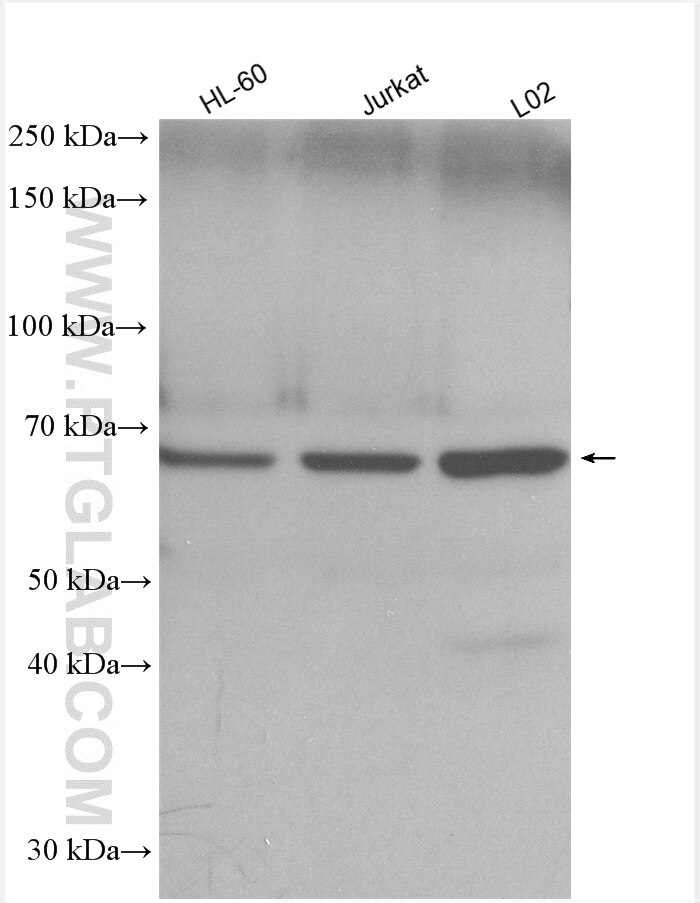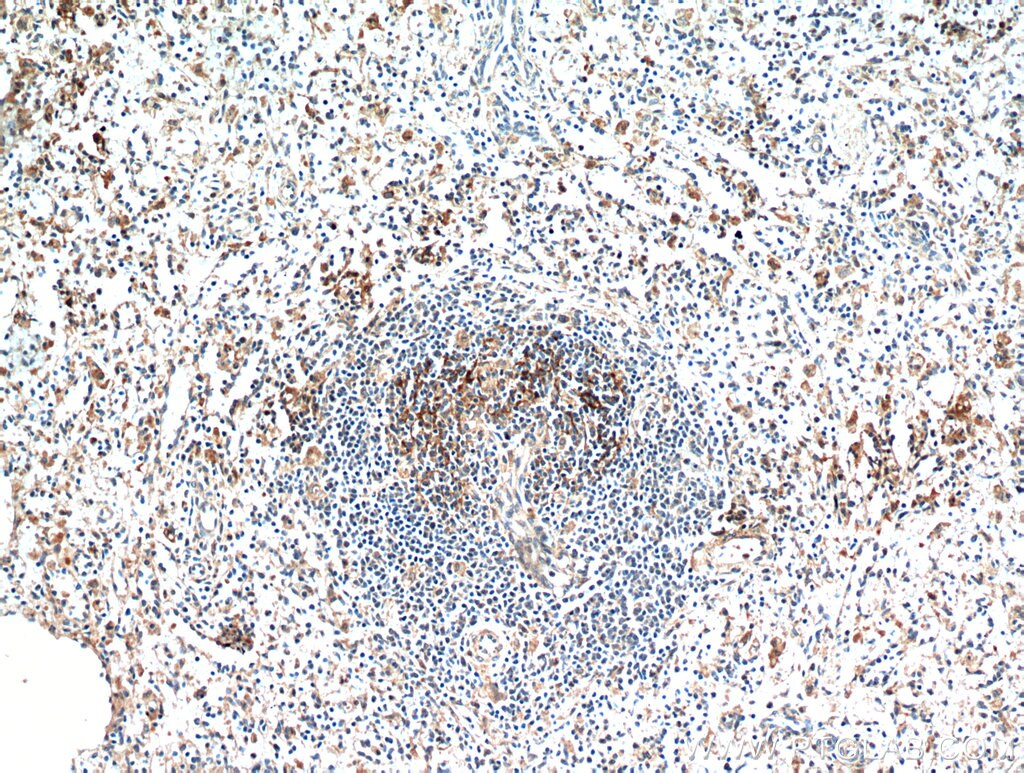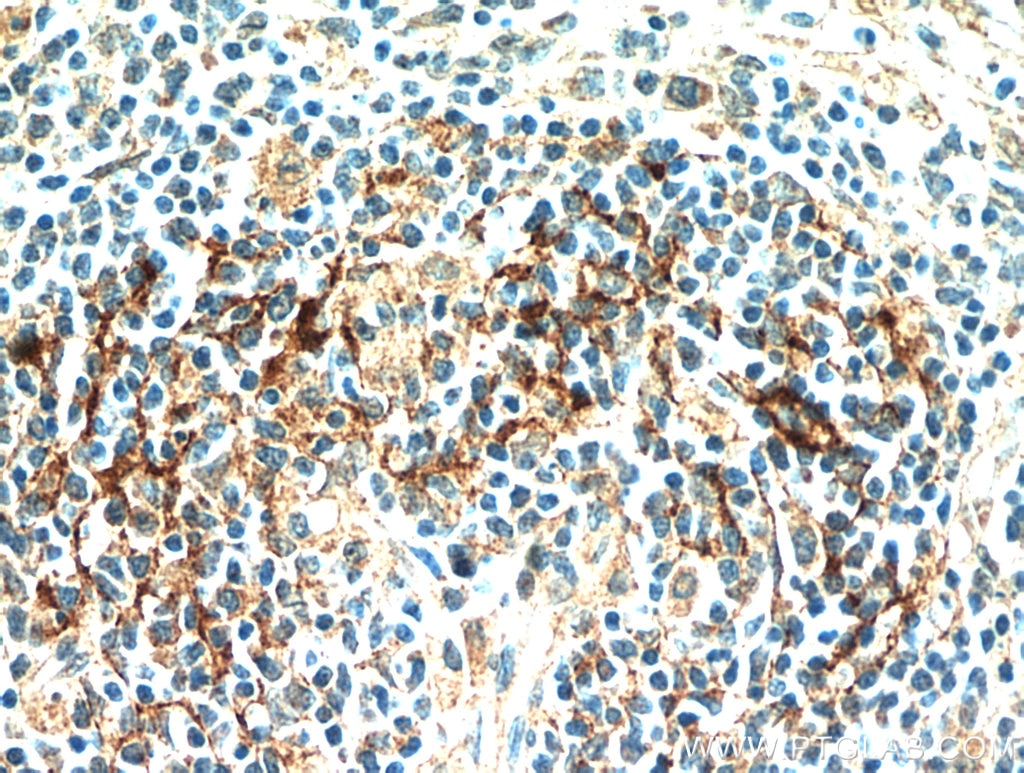Anticorps Polyclonal de lapin anti-JAML
JAML Polyclonal Antibody for WB, IHC, ELISA
Hôte / Isotype
Lapin / IgG
Réactivité testée
Humain et plus (1)
Applications
WB, IHC, IF, ELISA
Conjugaison
Non conjugué
N° de cat : 21302-1-AP
Synonymes
Galerie de données de validation
Applications testées
| Résultats positifs en WB | cellules HL-60, cellules Jurkat, cellules L02 |
| Résultats positifs en IHC | tissu splénique humain il est suggéré de démasquer l'antigène avec un tampon de TE buffer pH 9.0; (*) À défaut, 'le démasquage de l'antigène peut être 'effectué avec un tampon citrate pH 6,0. |
Dilution recommandée
| Application | Dilution |
|---|---|
| Western Blot (WB) | WB : 1:1000-1:4000 |
| Immunohistochimie (IHC) | IHC : 1:20-1:200 |
| It is recommended that this reagent should be titrated in each testing system to obtain optimal results. | |
| Sample-dependent, check data in validation data gallery | |
Applications publiées
| WB | See 2 publications below |
| IHC | See 4 publications below |
| IF | See 2 publications below |
Informations sur le produit
21302-1-AP cible JAML dans les applications de WB, IHC, IF, ELISA et montre une réactivité avec des échantillons Humain
| Réactivité | Humain |
| Réactivité citée | Humain, souris |
| Hôte / Isotype | Lapin / IgG |
| Clonalité | Polyclonal |
| Type | Anticorps |
| Immunogène | JAML Protéine recombinante Ag15900 |
| Nom complet | adhesion molecule, interacts with CXADR antigen 1 |
| Masse moléculaire calculée | 394 aa, 44 kDa |
| Poids moléculaire observé | 44 kDa, 50-70 kDa |
| Numéro d’acquisition GenBank | BC100797 |
| Symbole du gène | JAML |
| Identification du gène (NCBI) | 120425 |
| Conjugaison | Non conjugué |
| Forme | Liquide |
| Méthode de purification | Purification par affinité contre l'antigène |
| Tampon de stockage | PBS with 0.02% sodium azide and 50% glycerol |
| Conditions de stockage | Stocker à -20°C. Stable pendant un an après l'expédition. L'aliquotage n'est pas nécessaire pour le stockage à -20oC Les 20ul contiennent 0,1% de BSA. |
Informations générales
Junctional adhesion molecules (JAM-A, JAM-B, and JAM-C) are endothelial and epithelial adhesion molecules involved in the recruitment of circulating leukocytes to inflammatory sites (PMID: 19064666). JAML (junctional adhesion molecule-like), also known as AMICA1, is related to JAM proteins. It contains 2 extracellular immunoglobulin-like domains, a transmembrane segment, and a cytoplasmic tail. JAML is expressed on leukocytes and promotes their adhesion to endothelial cells (PMID: 12869515). JAML can regulate neutrophil transepithelial migration via binding interactions with epithelial coxsackie and adenovirus receptor (CAR) (PMID: 15800062). The full-length human JAML protein has a calculated molecular weight of 44 kDa. This antibody raised against 40-275 aa of human JAML protein detects bands with molecular wight of 44 kDa, and 50-70 kDa which probably represent different glycoforms of the protein (PMID: 12869515; 24621992; 15800062).
Protocole
| Product Specific Protocols | |
|---|---|
| WB protocol for JAML antibody 21302-1-AP | Download protocol |
| IHC protocol for JAML antibody 21302-1-AP | Download protocol |
| Standard Protocols | |
|---|---|
| Click here to view our Standard Protocols |
Publications
| Species | Application | Title |
|---|---|---|
J Transl Med Junctional adhesion molecule-like protein promotes tumor progression via the Wnt/β-catenin signaling pathway in lung adenocarcinoma. | ||
Eur J Pharmacol Resveratrol ameliorates diabetic kidney injury by reducing lipotoxicity and modulates expression of components of the junctional adhesion molecule-like/sirtuin 1 lipid metabolism pathway. | ||
Clin Sci (Lond) Silencing of junctional adhesion molecule-like protein attenuates atherogenesis and enhances plaque stability in ApoE-/- mice. | ||
Cancer Lett Distinct Immunophenotypic Profiles and Neutrophil Heterogeneity in Colorectal Cancer |




